Nearshore Software Development Guide

Nearshore Software Development Guide
We are living in the age of technology, where data and digital communication are the “new oil”. Businesses of all sizes have come to rely on software for nearly every aspect of their operations, from inventory management to human resources. And as the world goes increasingly digital, the demand for software only continues to grow.
Alongside the new trend, the world is facing the largest software developers talent gap in history. The companies are striving to find the right mix of skills and experience locally, often turning to outsourcing as a solution to tackle the problem.
The software outsourcing basics.
Outsourcing software development entails the use of a third-party contractor to perform work that could have been done in-house. Nearshore software development, for example, is an outsourcing model that allows companies to focus on their core competencies while still saving time and money.
There are three types of software development outsourcing models: nearshore, offshore, and onshore. The rise of software development outsourcing as a way to gain a competitive edge has led to much debate over which of the models would work best for the long-term goals of companies in the US or EU.
Now let’s take a closer look at nearshore development and how it stands out as the top option for businesses.
What is nearshore software development model
Nearshore outsourcing refers to the process of delegating tasks, particularly those related to software development, to neighboring countries in an effort to have more control over operational expenses. Nearshoring has a number of well-known advantages, including similar language, cultural proximity, and convenient time zones and geographical locations.
For example, Poland can serve as a perfect nearshore country for the Middle East (UAE and Israel) and Western and Northern Europe (United Kingdom, Germany, Netherlands, Sweden, Finland, Denmark, and Norway).
Nearshore software development services emerged to meet the demand of businesses that wanted to reduce time and distance offsets. These organizations learned that working with a nearshore firm saved them money while allowing them access to personnel for specific activities that could not be handled in-house.

Nearshoring vs onshoring
Onshoring refers to outsourcing software development work to a site within the same country. Onshoring is a form of domestic software development outsourcing. Software development projects are sent out of the country to another location. There are several advantages to onshore software development. Because the third-party team is in the same nation, communication with them becomes much easier and face-to-face meetings are possible. It also removes any cultural, legal, or tax issues connected with working across borders.
Onshoring, on the other hand, is more expensive than other outsourcing strategies and does not always alleviate the scarcity of skilled personnel. If there’s a dearth of talent in an area, it may also be a problem with local talent. Skilled developers, designers, and engineers frequently prefer to work for overseas companies. As a result, finding the best talents from within the country working at an on-shoring firm is often difficult.
Nearshoring vs in-house teams
It’s worth noting that in-house software development isn’t a form of outsourcing. If you’re creating software, one alternative is to keep it all inside the company, using its own personnel and resources. Many CTOs believe that in-house development teams are preferable for scaling software operations. You have complete control over the vision and product development by establishing an in-house software development team.
Overall, although there are many advantages to hiring technical in-house staff, it is often not possible for businesses. Software development projects necessitate the participation of a number of people with diverse talents and knowledge. Hiring specialists isn’t simple or inexpensive, and depending on the location, finding qualified candidates might be difficult.
Even if you hire a complete in-house staff, you must ensure they have access to the tools they need to do their work. This can be quite pricey and significantly raise your project budget. Finally, establishing an in-house staff might not be the answer in the long run.
For example, if you are wondering how to get started developing a website, we offer affordable and quick software programs that can be utilized on any sort of operating system or device. In certain areas, enterprises simply need help with a short-term or medium-term project from a team of developers. Nearshoring and other outsourced programming solutions allow companies to scale down personnel when they are no longer required. It is considerably more difficult to reduce staff when you have in-house talent.

Nearshore vs offshore: How is nearshoring different from offshore software development outsourcing?
Offshoring is the process of outsourcing IT services to distant locations in order to have a more streamlined hiring and budgeting process. Companies frequently choose nations with a large talent pool and lower hourly rates or salaries when seeking for a suitable vendor.
Time zones are also an important consideration during the selection process. To conduct calls and online meetings, in-house and remote teams must have at least a few hours of overlap. An offshore team can provide you with a high-quality product while still saving money at the conclusion of the project if you take the appropriate actions and exercise caution when making your choices.
The only factors that determine efficiency of offshore development are the quality and costs of engineers. Most of the time, offshore companies are located in another part of the world. For example, a company in Poland can be an offshore company to one in the US. One in Germany would be an offshore company one in Mexico.
On the other side, nearshore software development is the polar opposite, paying more attention to a much closer region. There are times when the difference in time between the two firms involved is greater than usual, but as long as the vendor is close enough to the employer, it’s considered nearshoring.
The advantages of partnering with a nearshore software development company
Nearshoring is good for your business due to a number of reasons. Here are a few of them:
1. Access to the know-how and a larger talent pool
The large worldwide talent pool is one of the main reasons why businesses are choosing nearshore software development. Because it is difficult to find expertise in each field and skill in-house, this is a major benefit of nearshoring.
When you outsource, you gain access to a trained staff in other countries—increasing your horizons and technological capability. It also gives you peace of mind knowing that each stage of the creation process is handled by an experienced team without the need for any additional training or supervision.
2. Lower costs of software development process
When you outsource software development, the income differences between developed and developing countries are significant. When you outsource, you save a lot of money on employee compensation and benefits (However we do not recommned taking cost as a major factor in software development process).
As a result, outsourcing software development and operations to developing nations generates larger economies of scale and lowers the cost of outsourcing software development and operations than doing it in-house.
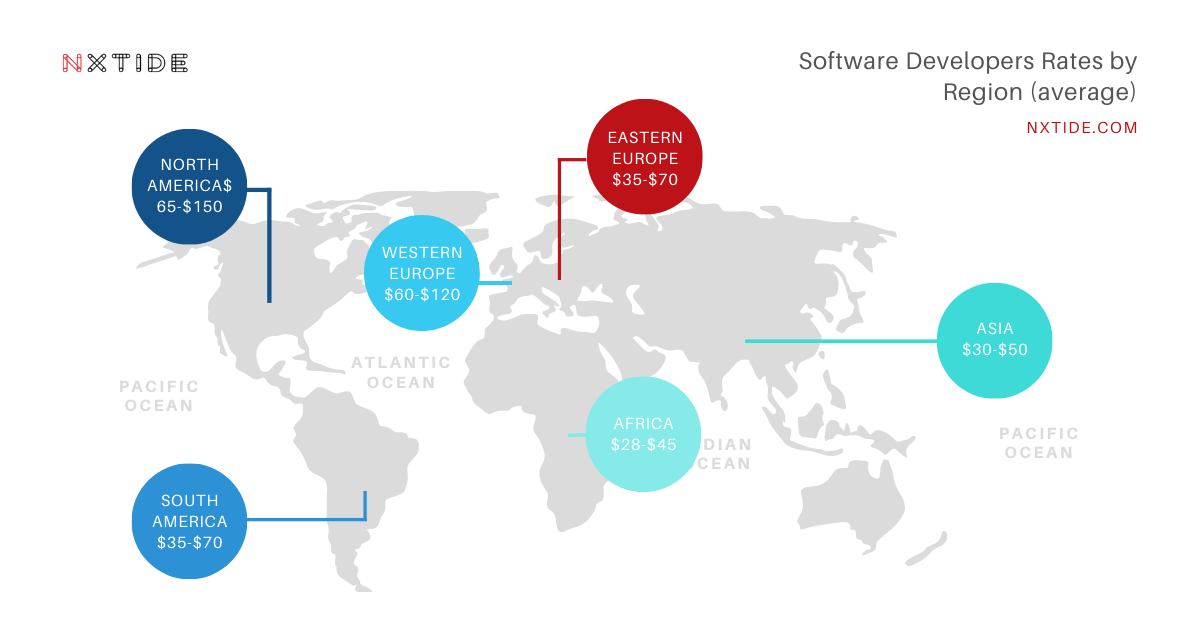
For more information regarding nearshore software development services rates please take a look at this article: https://nxtide.com/offshore-development-center/global-offshore-software-development-rates-comparison-by-country/.
3. Improved security
Assuming your in-house team doesn’t specialize in IT, there’s a chance that your software’s security is not secure. When there are security holes, your firm and its reputation are always at risk.
Nearshore software development companies offers more comprehensive coverage against security breaches on the IT front. There is a software team that will make sure the code and processes included in the development are safe and secure at all times.
4. Access to a scalable team
When demand is at its peak, you’ll need more resources. This generally necessitates the redistribution of in-house resources to processes and operations they aren’t knowledgeable in. It may also urge you to recruit new staff to assist with the workload. Unfortunately, both alternatives result in reduced effectiveness and increased expenses.
Parntering with w nearshore software companies, however, allows you to hire a scalable team for a fixed time period without the need to hire full-time employees permanently. Once the workload is balanced, you can save big bucks and encourage productivity.
5. Shorter “go-to-market” time
Companies around the world have recognized the importance of speed in operations and how it can be used as leverage against the competition. With nearshore outsourcing, there’s no need to depend only on available in-house resources to launch a product. Your nearshore software development vendor can adjust team extensions to product roadmap and simply allow the team to move faster.
With more control comes greater flexibility, as you have complete control over timelines according to your own schedule. Dedicated developers are also available to deliver IT services according to that particular timetable.
6. Improved risk management
Experts advise diversifying your investment portfolio rather of putting all of your money in one basket to minimize risk throughout the investing process. The same can be said for nearshore outsourcing. It’s highly volatile, so you’ll need a solid risk management strategy to ensure long-term success.
You may reduce risks by dividing operations and components and handing them out to several vendors. Just make sure you do some study, contact previous clients of your vendor, evaluate their industry expertise, and then decide if they are the right one for you.
7. Improved focus on core business
In today’s competitive tech business, firms must find new methods to develop and grow in order to remain competitive. Nearshore software development outsourcing not only minimizes attention on core procedures, but it also prevents your in-house staff from being bogged down with responsibilities that are beyond their abilities. This allows them to concentrate on long-term strategic objectives while still contributing to the company’s success.
As a result, your business processes are streamlined and resources are allocated to more important areas.
8. More support options
The software requires ongoing support and maintenance. After product release, a specialist staff is required to manage the constant changes and flaws. You are already paying your software team for assistance and upkeep since you use nearshore development.
Some nearshore software development companies provide great options of support services after the project is finished.
How to find a good nearshore development company
Nearshoring Now that we’ve determined the benefits of switching to nearshore software development, it’s time to discuss how you can find a reliable service provider for your company. Below are some factors to consider when selecting a nearshore company for your software needs.
Commitment to security
With more businesses turning to third-party providers to safeguard their goods from cyberattacks, you need to understand how a service provider intends to incorporate security into your program. A good nearshore partner should be able to show you their commitment to cybersecurity by offering a proper overview of their strategy. They must also demonstrate their way of handling sensitive data, backups, and storage. An effective security plan starts in the planning stage and should go on through the testing phase.
Proven track record
Before fully committing to hiring an outsourced partner, it’s imperative to carry out due diligence and research their reputation in the industry. One great place to look at is the vendor’s official website. Are there testimonials from verified former clients that attest to the work quality they provide?
It’s also wise to check their portfolio and the projects they have completed in the past, as well as the outcomes of those projects. Reliable nearshore software development companies can proudly discuss their previous projects with confidence. This serves as proof that they were able to deliver a solution that reached the client’s standards.
Pro-active, clear communication
A trustworthy nearshore company puts communication at the top of its priority. Through the use of project management tools (i.e. Trello, Basecamp, Hira, etc.), a company shows its commitment to ensuring clear communication with clients. Communication platforms allow remote and in-house teams to collaborate better. These channels also enable teams to directly reach out to clients.
With open communication channels in place, you’ll have an overview of how the project is progressing at each stage. You can see who is responsible for certain tasks and when they are scheduled to be completed.
Tech expertise that matches your skill gaps
Outsourcing software development to a neighboring nation allows you to choose from a larger number of highly-trained individuals. After assessing your in-house staff’s abilities, it’s time to outsource the knowledge that it lacks.
For instance, your internal team may be excellent in terms of UX design but lacks the JavaScript expertise to make your product functional. When looking for a nearshore partner, they should provide the skills that complement your existing IT infrastructure for better results.
Structure of governance and management
It’s usually a sign of good practice when a nearshoring partner follows ISO, ITIL, or other standards. If you want to know if they’re a good fit for your organization, look to see whether their governance structure is similar to yours.
Examine how they approach stakeholder management, independent testing, issue logging, and risk registers. Find out the company’s perspective on transparency and reporting, as well as the amount of control you can have over the development process. The more aligned your company is with the service provider, the more efficient the process of development will be.
Flexibility in T&C area
Software development, much like any other project, entails its own set of difficulties. However, with improved architecture, these obstacles will be considerably simpler to overcome. You’ll have a more efficient and cost-effective development process if non-functional criteria such as scalability, data migration, performance, and security are considered from the start.
Is your nearshore software development partner capable of adapting to change when necessary? Do they excel at adopting various working practices? Are they experienced when it comes to applying certain approaches to software development? Those are a few of the questions you need to ask before settling on a service provider for your software development project.
Build-Operate-Transfer option.
There are a number of different ways that companies can set up their offshore / nearshore development office in Poland. One option is the Build-Operate-Transfer (BOT) model. Under this model, the local software development company (partner) sets up and operates the offshore / nearshore development office for a period of time (usually 3-5 years), after which it transfers ownership of the office to the client. This BOT model has a number of advantages you can read in this article.

How to build a Nearshore Software Development Team

Globalization and digitalization of work have created high competition for companies looking to hire people with certain skills like software development. The increasingly rising demand on the local market triggers higher wage costs and longer timeframes required to find talent. All of this is forcing companies to look for solutions beyond borders. In this article, we’ll take a quick look at IT nearshoring and how to use it to build successful software development teams serving typical business needs.
Offshore vs nearshore vs in-house software team
We all understand that the primary choice for every company would be to have all its resources in-house and we know why sometimes it isn’t simply possible. The second choice is nearshoring (also called nearshore outsourcing), which stands for running software-related activities in a country near your business location (in comparison to offshore location eg. in Asia). It’s very than different from traditional offshoring, as nearshoring has a mix of benefits of in-house and offshore solutions: A nearshore software team can share your location, which facilitates daily communication and collaboration. The nearshoring also has the following benefits:
– The team’s setup costs are much lower because there are no major infrastructure investments required to start nearshore operations.
– Nearshore software development teams have higher quality standards compared with offshoring ones, as they aspire to remain nearshore for future business evolution.
– The team has fewer cultural and language barriers, reduced communication timeframes, and therefore faster delivery.
The best locations for building a software development hub
Nearshore software development locations can be found all over the world, but they are rapidly growing in popularity, now that more and more companies focus on digital transformation. Below you’ll find the best of nearshore software development locations (and some not-so-nearshore) based on popularity. In the next paragraphs, we will try to focus more on a specific one.

1. India
India is the most popular place in the world for nearshore software development centers. It’s well-loved by many companies thanks to lower salaries than western countries’ standard rates, high quality of developers, and a huge number of universities producing new skilled professionals every year. There are different regions ideal for various types of projects so it might be worth considering multiple locations when choosing an offshore destination. NearshoreHub has prepared a comprehensive guide about outsourcing to India.
2. Mexico
Mexico is another attractive location with oceanic as well as cultural closeness to the US. The same as with other nearshore software development destinations, there are certain regions that specialize in different industries and functions. Nearshore Hub has also prepared a guide about outsourcing to Mexico.
3. Bulgaria
Bulgaria is considered one of the most successful offshoring destinations and currently holds first place among European countries for fastest-growing IT exports (in Europe). It’s not surprising: Bulgaria provides high-level professionals at affordable prices, English proficiency is widespread, and IT companies enjoy government support and a favorable taxation system.
4. Brazil
Brazil has always been a great option for Nearshore outsourcing in terms of software engineers’ salary costs in comparison to other locations. There’s also no shortage of high-quality universities producing skilled professionals in computer science or engineering every year (more than 700 colleges), which makes the labor market very competitive.
5. Ukraine
Ukraine is the 2nd leading country in Eastern Europe (after Poland) when it comes to IT outsourcing and nearshore software development. The quality of Ukrainian professionals is well known, and their labor costs are lower than in most European countries (Poland, for example). The main advantage of outsourcing to Ukraine is that you can hire Web, Mobile, Back-end developers with quite good English language skills
6. Poland
The software developers’ rates in Poland are higher than in Ukraine, but still much more attractive than in Western Europe. In comparison to other locations, this country offers better stability, infrastructure, and higher standards and work ethics (comparable to western countries). The big tech companies have already taken advantage of these facts and opened their local IT R&D Centers (eg. Google). Education level and technical training at universities is also on a very high level. Furthermore, Poland with its rising IT graduates is expected to have over 620k software developers in 2025 reaching almost 25% of the regional supply. This is why we will focus on this country as the preferred nearshore software development team location.
7. Philippines
The Philippines was always famous as an offshore outsourcing location for English-speaking work such as customer support or data entry. Nowadays the focus points have shifted towards website design and web application programming thanks to young graduates from colleges pursuing eLearning degrees with IT specializations. Nearshore Hub has written a Guide to Outsourcing to the Philippines you might find useful if you’re planning your outsourcing location in the Asia Pacific.
8. Egypt
Egypt currently holds 22nd place on the world economic freedom rating, which is lower than other locations we’ve mentioned above; however, it provides high-quality talent at affordable rates making Egypt competitive enough for nearshore software development.
9. Malaysia
Malaysia is considered the best choice for companies looking to outsource software development in Asia. The country takes first place on competitiveness rankings among Southeast Asian countries and holds the 35th position among other countries globally. Malaysia’s strong points are a highly qualified workforce, English proficiency, developed infrastructure, and a great number of IT professionals with programming & engineering degrees coming from well-known universities such as Stanford and Berkeley.
10. Romania
Romania is another Eastern European location offering great opportunities for nearshore software outsourcing. English proficiency of the workforce in Romania is considered good, although it doesn’t match the level of English-speaking professionals in other nearshore hubs. The choice of the depends on your company location and needs. If you prefer quality, stability, safety, and good infrastructure you should focus more on nearshore locations in Central-Eastern Europe with a preference to EU countries.
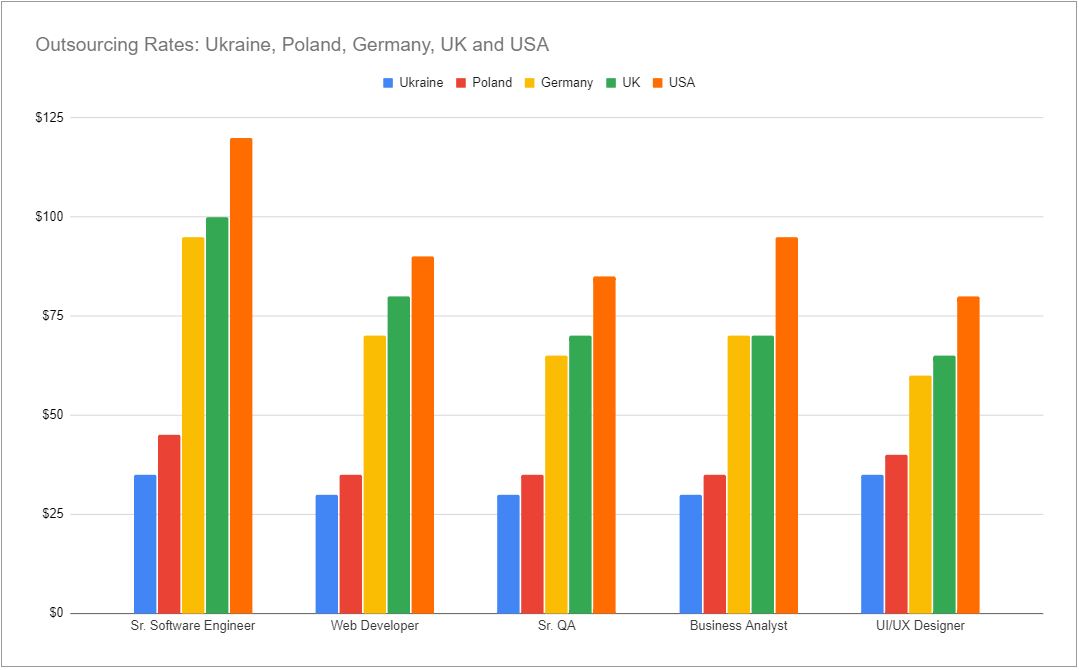
Is Poland a good country for nearshore software development?
Location and tome-zones
Time zones are also an important consideration during the selection process. To conduct calls and online meetings, in-house and remote teams must have at least a few hours of overlap. An offshore team can provide you with a high-quality product while still saving money at the conclusion of the project if you take the appropriate actions and exercise caution when making your choices.
The only factors that determine efficiency of offshore development are the quality and costs of engineers. Most of the time, offshore companies are located in another part of the world. For example, a company in Poland can be an offshore company to one in the US. One in Germany would be an offshore company one in Mexico.
On the other side, nearshore software development is the polar opposite, paying more attention to a much closer region. There are times when the difference in time between the two firms involved is greater than usual, but as long as the vendor is close enough to the employer, it’s considered nearshoring.
Attractive nearshore software developers rates
Polish software developers are among the most affordable in Europe. Their rates are up to 60% lower than the rates in other Western European countries. The typical hourly rate for a Polish offshore developer is $25-$35, which is much lower than the rates in the UK ($50-$100) and the US ($75-$150). The table below shows some more details on this topic.
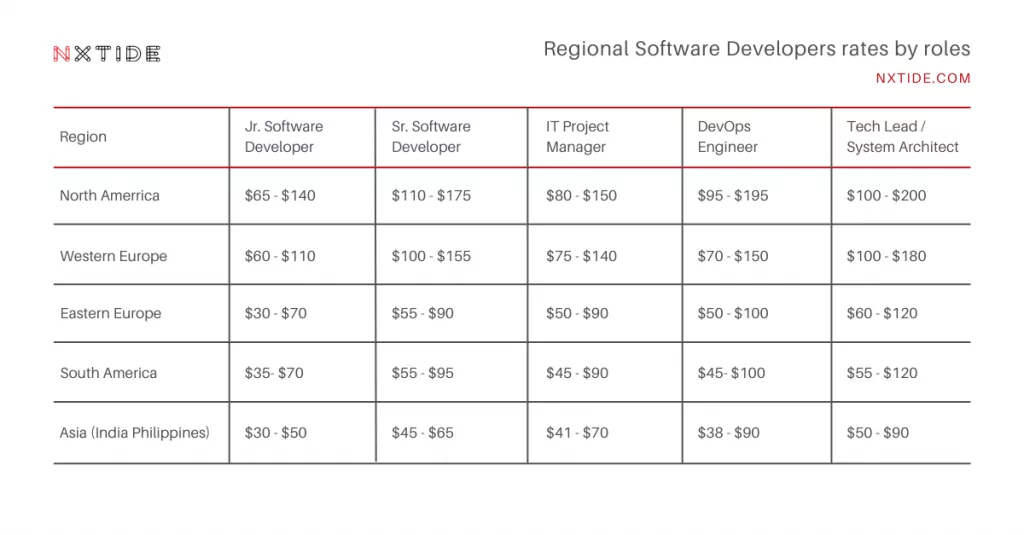
The country has a well-educated and highly skilled workforce
As mentioned before, over 60% of Polish software developers have university degrees in computer science or mathematics. Additionally, the country has a well-educated and highly skilled workforce. According to the latest World Bank report, Poland ranks high in terms of pupil-teacher ratio (1:14) and gross tertiary enrollment rate (77%). This places Poland ahead of countries such as Germany, France, and the UK.
The polish student’s scores are also pretty good. In the latest PISA (Programme for International Student Assessment) study, Poland ranked 13th out of 72 countries in mathematics, 9th in science, and 5th in reading. This proves some huge human potential for offshore / nearshore software development services.
Polish software engineers are fluent in English making communication easy and efficient
Polish software developers are fluent in English, which makes communication easy and efficient. In fact, most of them have at least C1 level of English proficiency, according to the Common European Framework of Reference for Languages. This makes it possible for companies to communicate with them directly without the need for any translation or interpretation services.
Communication with software engineers is a very important factor in setting up a successful Nearshore Software Development Office or Offshore Development Center.
The Hackers Global Rank placed Poland 5th in the world for software development outsourcing. The other ranks that prove the high quality of skills:
– Nearshore Value Index: Poland is in 3rd position
– The best offshore destinations for IT outsourcing: Poland is in 5th position
– 50 countries with the best developers: Poland is in 8th position
The strong work ethic
Polish workers are known for their strong work ethic through years of working abroad and in many BPOs. They are highly motivated and always willing to go the extra mile to get the job done. Close relations with the western countries provided also huge improvements when it comes to standards and frameworks crucial for the effectiveness of work.
Here is a quote from one of the former MS-Tech Directors: “I am extremely happy with the developers I have working for me and would not hesitate to recommend this destination to anyone looking for a nearshore software development office.”
The favorable location
Poland also has a strategic location – it is located in Central Europe, making it easy for companies from all over the world to reach it. Additionally, Poland has favorable time zones – it is in the same time zone as the UK and the US, which makes it possible for companies to communicate with their developers easily and efficiently.
The vibrant business climate with great infrastructure and a stable economy
Another important factor to consider before setting up a nearshore development office or offshore software development center is the business environment.
Poland offers a favorable business climate with low taxes and a stable economy. In fact, it is one of the most promising economies in Europe. The global “Doing Business Rank” place country in the 38th position, out of 190 economies.
Poland also has excellent infrastructure, including high-speed internet and transport links. This makes it easy for companies to do business without any limitations. According to the latest data, the country has the fastest average internet speed in Europe – at 113.6 Mbps.
Poland is a member of the European Union since 2004
Poland offers great potential for offshore software development. As a member of the European Union, it provides investors and companies with access to the largest single market of over 500 million people. This is a very significant advantage over many offshore software development locations.

The developed business support and outsourcing services sector
Poland has a well-developed business support and outsourcing services sector. This includes a wide range of services, such as legal, accounting, HR, and marketing services, which companies can use to help them set up and run their nearshore software development office or offshore development center.
The large potential of CEE region

The nearshore market of CEE region is large enough to provide nearshore outsourcing services for all types of companies. The region offers enourmous IT talent pools (over 1 milion) combined with good infrastructure and quality nearshore software development services. The CEE nearshore market is forecasted to grow over the next few years. This can be proved by the nearshore deals concluded in the region. Research of U.S. Investments in CEE nearshore deals shows that 80% of nearshoring companies are located in Poland, Hungary and Czech Republic. This statistics proves high demand of nearshore software outsourcing services provided by global nearshore hubs of Central-Eastern Europe countries.
The composition of the nearshore software development team
Team composition can also heavily depend on your company needs… for example, if you are working on a website, the team will need to include web designers as well. Additional roles that you might need to hire: mobile developers, QA automation developers (Selenium), and/or Dev-ops engineers. In fact, every software development team needs to be balanced. It’s a simple rule – to succeed, your team needs great programmers, experienced testers, and outstanding project leaders. The basic structure of nearshore teams should therefore include:
– Back-end Developers
– Front-end Developer(s)
– Quality Assurance Engineers/Managers
– Project Manager(s)
If your budget allows it you can also add business analysts, QA automation engineers (using QTP/UFT or Selenium). There is no golden number when it comes to size. At NxTide we have seen very successful nearshore software development teams with no more than 10 people on board. In fact, we believe that smaller teams perform better in the remote work environment, The real thing you should focus on is “the quality” not quantity.
How to recruit the best software development teams
The nearshore software development location you choose is not the only factor that will influence your success. You will also need to hire the best nearshore software development team available.
When searching for nearshore software developers, it is highly recommended to focus on the holistic strategy called the 3 Cs:
– Communication skills (C): nearshore teams use mostly English as a working language and it’s very important that each team member has good communication skills.

– Capability (C): nearshore programmers need to be highly skilled in their areas of expertise.
– Culture (C): nearshore software development companies tend to create teams based on one culture and achieve success in nearshoring projects when they do so. When we think about nearshore location, we mean company culture and not national culture; therefore your nearshore software development team can be 100% Polish but still have Swedish, French, or American corporate culture and approach towards IT projects.
Where to find the best software developers
Knowing how to recruit the people we want is 50% of the success. The other side of the coin is where to find the best employees in a short period of time. We assume that the whole team composition process shouldn’t last more than 6 months. This is not an easy task but it’s definitely achievable.
First of all, you need to build up your local company brand and then promote it in the right places like:
– popular local job boards
– industry forums
– specific Facebook groups
– LinkedIn groups industry
– events (meetups, conferences)
The other strategy worth mentioning is executive search (direct messaging) conducted by your HR department. This approach is more expensive but in the long run, it’s worth every penny. It’s is effective in finding seasoned professionals who aren’t very active on the job market. The other approach is to partner with the local outsourcing partner offering specifically nearshore teams development. There are probably dozens of HR agencies that will promise you everything you could imagine within a short period of time. The truth is that they don’t really know who nearshore programmers are and where to find them. This is why it makes a lot of sense if you partner with a real nearshore software development company (eg. NxTide) that is specialized only in nearshoring services.
Cooperation with nearshore software development partner
Your future, nearshore software development partner should be a company you can trust and rely on. Of course it’s important to make sure that the people you hire are good enough but this is only 50% of the success. The real deal is to understand what your local IT company should do for you – basically, offer full scope of nearshore services not just some random outsourced programmers. You do not want to work with HR agencies or outsourcing companies – but with the real IT partner taking the same risks and burdens to yours. This way is the right way.
Some of the best, specialized, nearshore companies could offer a cooperation model called “Build-Operate-Transfer” (the latest trend in nearshore development services). The BOT is simply a model where nearshore outsourcing partner builds the necessary infrastructure, hire nearshore development team and then transfer all operations into the customer’s hands. (more about benefits of Built Operate Transfer model)
Phase 1: Build
First, we setup your brand on our career website to make sure candidates are well informed. Then we run marketing campaings alongside direct search activities to attract the best talent to your future IT Hub.
Phase 2: Operate
Our Project Managers takes care of the onboarding, employee wellbeing and team building activities. Our role is to make sure everything runs smoothy so that you can reach scale with ease.
Phase 3: Transfer
Upon your request, we transfer the fully operational IT Hub to the Client making you the owner of the of it. You can can still take advantage of our support, so the cooperation and scaling can be continued.
At NxTide we have been working in nearshoring industry for more than 6 years, therefore our clients have never been disappointed with results from one of their outsourcing projects. We know exactly how to find a qualified nearshore development teams and how to set up a proper project management process. Our customers say, that nearshoring works flawlessly every time thanks to our specialized HR teams with a great help of exceptional IT project managers. Would you like to know more? – book a call with us.
Nearshore Software Development Trends in 2023

The nearshoring of information technology (IT) is a business trend that refers to the movement of IT services and functions from high-cost locations, such as North America and Western Europe, to lower-cost countries in Eastern Europe or South America.
There are several reasons why companies choose to nearshore their IT functions by building Nearshore Development Office. The most common reason is to save money on labor costs. Other reasons include access to a larger pool of qualified workers, cultural similarities between the company and the nearshore country, and political stability.
IT nearshoring has become an increasingly popular option for companies over the past decade as the cost of living and doing business in high-cost countries has continued to rise. In addition, the availability of high-speed internet and advances in communication technology have made it easier for companies to work with nearshore teams.
As we move into 2022, there are several trends that are likely to impact the nearshoring of IT services. Here are ten of the most important ones:
The continued rise in labor costs in high-cost countries
Finding software developers is more and more difficult in western countries. The competition is so big that the companies have to pay more and more to attract the best IT talents. The trend is not going to change in 2022 and in the years to come. This will lead more and more companies to look for nearshoring options in order to reduce their development costs.
The availability of skilled workers in lower-cost countries
As the demand for nearshoring increases, so does the pool of qualified workers in lower-cost countries. This is especially true in countries with a large population of young people, such as Mexico, Brazil, India, Indonesia, Poland, Romania, and Turkey.
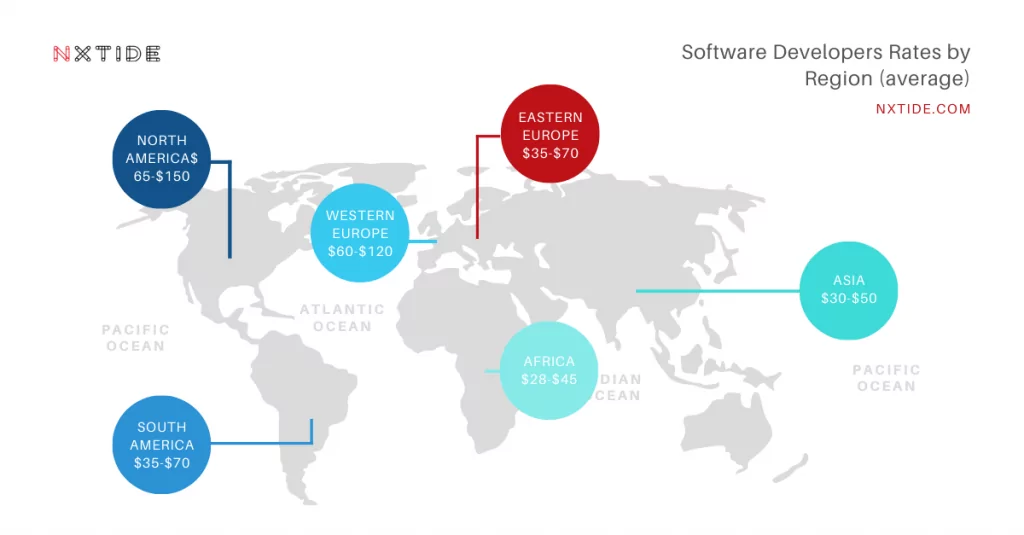
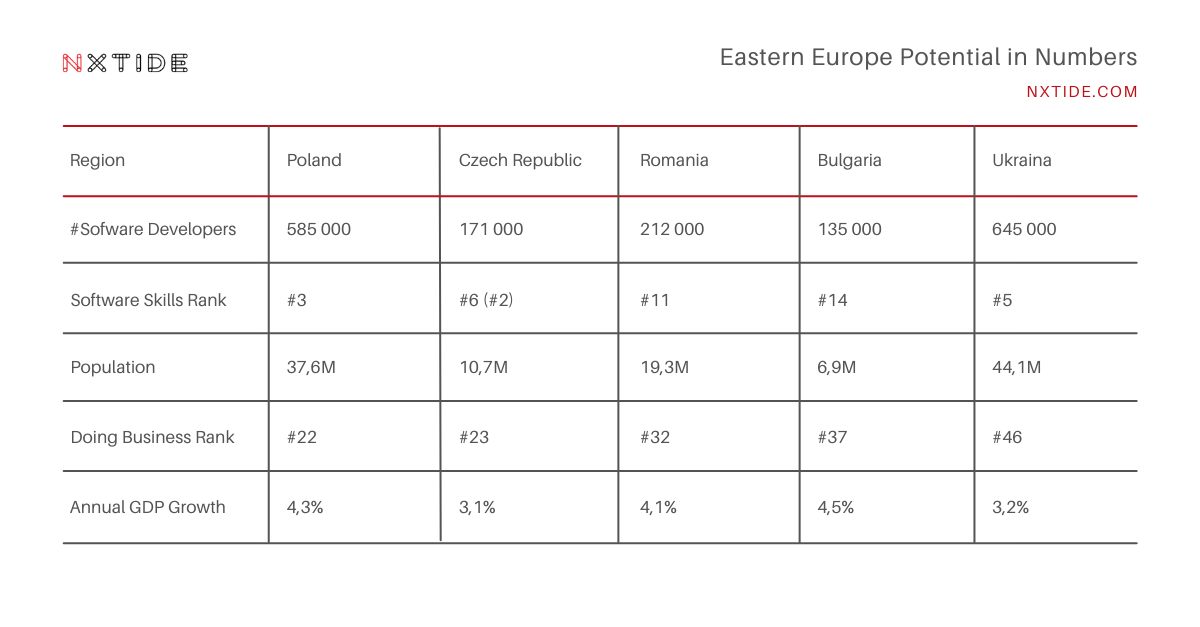
For more information regarding nearshore software development services rates please take a look at this article: https://nxtide.com/offshore-development-center/global-offshore-software-development-rates-comparison-by-country/.
The increasing use of artificial intelligence (AI) and automation
AI and automation are changing the landscape of many industries, including IT. As these technologies become more sophisticated, they will increasingly be used to replace human workers in a variety of tasks, from customer service to software development. This trend is likely to continue in 2022 and beyond, which will make nearshoring an even more attractive option for companies looking to reduce labor costs.
The growth of the gig economy
The gig economy is a term used to describe the increasing prevalence of short-term, contract-based work. This type of work is often done remotely, which makes it well-suited for nearshoring. In addition, the gig economy is growing rapidly, which means there will be an increasingly large pool of workers available for companies to choose from.

The rise of the remote worker
The COVID-19 pandemic has forced many companies to allow their employees to work remotely. This trend is likely to continue in the future, even after the pandemic ends, as more and more companies realize the benefits of remote work. This will make it easier for companies to nearshore their IT functions, as they will no longer be limited to workers in a specific location.
The rise of edge computing
Edge computing is a term used to describe the process of storing and processing data closer to the devices that are generating it. This is often done in order to reduce latency and improve performance. As more and more devices are connected to the internet, edge computing is becoming increasingly important. This trend is likely to continue in 2022 and beyond, which will make nearshoring an even more attractive option for companies looking to reduce latency and improve performance.
The increasing demand for cloud services
Cloud computing is a term used to describe the delivery of computing services over the internet. These services are often delivered on a pay-as-you-go basis, which makes them more flexible and cost-effective than traditional on-premises solutions. The demand for cloud services is growing rapidly, and this trend is likely to continue in 2022 and beyond. This will make nearshoring an even more attractive option for companies looking to reduce their IT costs.
The growth of the Internet of Things (IoT)
The Internet of Things (IoT) is a term used to describe the growing network of physical devices that are connected to the internet. These devices can include everything from cars and appliances to manufacturing equipment and medical devices. The IoT is growing rapidly, and this trend is likely to continue in 2022 and beyond. This will make nearshoring an even more attractive option for companies looking to reduce their IT costs.
The increasing use of Big Data and analytics
Big Data is a term used to describe the large and growing volumes of data that are being generated by businesses and individuals. This data can be used to improve decision-making, identify new opportunities, and optimize processes. The demand for Big Data and analytics is growing rapidly, and this trend is likely to continue in 2022 and beyond. This will make nearshoring an even more attractive option for companies looking to reduce their IT costs.
The increasing demand for cyber security
As the world becomes increasingly digitized, the need for cyber security is also increasing. This is because more and more businesses are storing sensitive data online, which makes them vulnerable to attack. The demand for cyber security is growing rapidly, and this trend is likely to continue in 2022 and beyond. This will make nearshoring an even more attractive option for companies looking to reduce their IT costs.
The rising importance of nearshoring companies
Nearshoring business is getting more mature and consolidated. The demand for this type of B2B service is rising. This means that more businesses are turning to nearshoring companies for support in local markets. This trend is likely to continue in the future, as more businesses realize its benefits. This will make it easier for companies to find the right partner for their IT needs and will make nearshoring an even more attractive option.
Frequently asked questions about nearshore software development
What is nearshore software development?
Nearshore software development is a type of outsourcing that involves working with a software development team in a nearby country. The term “nearshore” refers to the geographical proximity of the outsourcing location, which is typically located within a few time zones of the client’s location.
What is the difference between offshore and nearshore software development?
The terms “nearshore” and “offshore” are used to describe different types of outsourcing, with nearshore outsourcing being closer to the client and offshore outsourcing being further away.
Nearshore outsourcing involves working with a software development team in a nearby country, typically within a few time zones of the client’s location. This can result in a more efficient and effective outsourcing experience, as well as a better project outcome, due to the reduced time and costs associated with communication and collaboration, as well as the ability to more easily manage the outsourcing relationship.
On the other hand, offshore outsourcing involves working with a software development team in a country that is significantly further away, typically across multiple time zones and often in a different region of the world. Offshore outsourcing can offer cost savings due to the lower labor costs in the outsourcing location, but can also result in challenges with communication and collaboration, as well as a higher risk of cultural and language barriers.
In summary, the main difference between nearshore and offshore outsourcing is the proximity of the outsourcing location to the client, with nearshore outsourcing being closer and offshore outsourcing being further away. Both types of outsourcing have their own advantages and disadvantages, and the best choice will depend on the specific needs and requirements of the business.
How much does nearshore software development cost?
The cost of nearshore software development can vary depending on several factors, including the location, the skill level of the developers, and the demand for software development services. However, in general, nearshore software development is typically more expensive than offshore software development, but less expensive than onshore software development.
On average, nearshore software development hourly rates can range from $50 to $150 per hour, depending on the location and the skill level of the developers. For example, software development outsourcing to countries in Eastern Europe, such as Poland and Ukraine, typically costs between $50 to $100 per hour, while outsourcing to countries in South America, such as Brazil and Argentina, typically costs between $80 to $150 per hour.
What are the benefits of nearshore software development?
There are several benefits to nearshore software development, including:
Proximity and Time Zone Compatibility: Nearshore software development allows businesses to work with a development team in a nearby country, typically within a few time zones of the client’s location. This proximity can reduce the time and costs associated with communication and collaboration, as well as the ability to more easily manage the outsourcing relationship.
Cultural Similarities: Nearshore software development can leverage cultural similarities between the client and the outsourcing location, which can help to build strong and effective working relationships. This can also result in a better understanding of the client’s needs and requirements, which can lead to a better project outcome.
Cost Savings: Although nearshore software development is typically more expensive than offshore software development, it can still result in cost savings compared to onshore software development. Additionally, nearshore software development can offer a cost-effective solution for businesses looking to outsource software development while minimizing the risks and costs associated with offshore outsourcing.
Access to Skilled Developers: Nearshore software development locations typically have a large pool of skilled software developers, which can provide businesses with access to the talent and expertise they need to deliver high-quality software development services.
Improved Quality: By working with a nearshore software development team, businesses can benefit from the proximity and cultural compatibility, which can result in improved communication and collaboration, as well as a better project outcome.
In conclusion, nearshore software development can offer a cost-effective and efficient solution for businesses looking to outsource software development, with benefits including proximity, cultural similarities, cost savings, access to skilled developers, and improved quality.
What are the risks of nearshore software development?
Like with any outsourcing arrangement, nearshore software development also has some potential risks that businesses need to be aware of, including:
Communication Barriers: Although nearshore software development can reduce the risks associated with communication and collaboration, there may still be language or cultural barriers that can impact the quality of the communication and collaboration.
Quality Concerns: Although nearshore software development can offer access to skilled developers, there may still be concerns about the quality of the work, especially if the outsourcing location does not have a strong reputation for delivering high-quality software development services.
Dependence on a Single Location: By relying on a single nearshore location for software development, businesses may be exposing themselves to risks associated with that location, such as political instability, economic downturns, or natural disasters.
Security Risks: Nearshore software development can result in sensitive business information being stored or processed in a different country, which can pose security risks, especially if the outsourcing location does not have strong data protection laws or regulations.
Contractual Risks: As with any outsourcing arrangement, nearshore software development can also result in contractual risks, such as disputes over payment or intellectual property rights.
In conclusion, while nearshore software development can offer several benefits, it is important for businesses to be aware of the potential risks and to carefully consider their specific needs and requirements when choosing an outsourcing location. It may also be helpful to work with a reputable outsourcing company to manage the outsourcing process and minimize the risks associated with nearshore software development.

Create a Nearshore Software Development Office with NxTide
Over our 7-year company activity we have helped many US and EU companies to successfully build Software Development Teams and Software Development Centers in a variety of locations in Poland.
Interested? – Let’s discuss your case on a call.
Marcin Dziedzic, CEO of Pragmatic Coders and NxTide.
Looking for a solid nearshore software development company?
Opening a Nearshore Software Development Office in Poland can be a great opportunity for businesses looking to outsource their software development projects. By partnering with a reliable and experienced nearshore development company, you can get access to a team of skilled software developers who can help you deliver high-quality projects on time and within budget.
Looking for a Nearshore Development Office in Poland? Contact us now! We are a reliable and experienced nearshore development company with offices in Krakow, Warsaw, Katowice and more.
About Us:
NxTide is a specialized company focusing on building local, Software Development Teams or larger Software Development Centers in major cities in Poland. We take care of all recruitment and quality control processes making it faster and more cost-effective for you. Here is some more information about our expertise: – Over 7 years of experience in creating a variety of software development teams – Over 60 teams and 300 engineers successfully hired and deployed – Several dedicated HR and IT Project Management Teams acting on your behalf.
Please take a closer look at a dedicated and flexible offer we have prepared based on market needs:
1) Software Development Teams: dedicated to clients looking to expand their software development teams or create small remote teams from scratch.
2) Offshore Development Center: dedicated to larger and permanent projects. We’ve implemented the innovative Build Operate Transfer model to make the whole process faster, more efficient, and transparent.
3) Nearshore Software Development Office: dedicated to larger and permanent projects within the same region, and continent.

Kraków
Over 0,8M population, 13% of total IT Engineers supply

Warsaw
Over 1,8M population, 24% of total IT Engineers supply

Wrocław
Over 0,7M population, 12% of total IT Engineers supply

Katowice
Over 1,8M population, 9% of total IT Engineers supply

Poznań
Over 0,7M population, 8% of total IT Engineers supply

Łódź
Over 0,7M population, 7% of total IT Engineers supply

Gdańsk
Over 0,6M population, 6% of total IT Engineers supply

Bydgoszcz
Over 0,5M population, 4% of total IT Engineers supply
Other related articles that might interests you:

The Top 10 Reasons Companies Use Software Development Nearshoring Services.
Home The Top 10 Reasons Companies Use Software Development Nearshoring Services. Software development nearshoring (IT nearshoring) is a new popular…

IT Nearshoring – The New Trend In IT Outsourcing Industry
Home IT Nearshoring - The New Trend In IT Outsourcing Industry The IT industry is booming and companies are always…

What is a Build Operate Transfer model in IT outsourcing?
Home What is a Build Operate Transfer model in IT outsourcing? The Build Operate Transfer model (BOT) in the IT…
